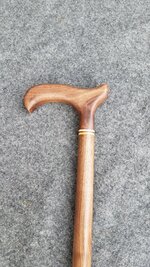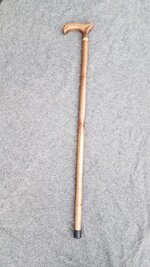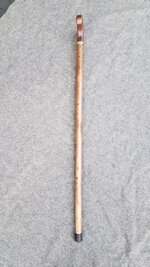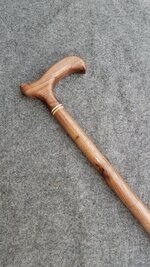Last year, I got on a kick about making canes. I also have a midi-lathe and opted for making them in sections that I (mostly) glued together using dowels. But to avoid an ugly grain match at the joints, I opted to embed a small (1/4") decorative ring to disguise the joints. The rings were formed from 1/4" thick face grain timber with a hole that fit over a tenon cut on one end of one of the pieces making up each joint. Because the tenon was only a 1/8" smaller than the diameter of the shaft, inserting the rings don't compromise the strength of the joint. But because they were face grain (and in some cases, a contrasting timber), they draw attention away from the joint itself.
On some of my canes, I used a length of allthread rod instead of a glued-in dowel for the middle joint. The rod was epoxied into the the shaft on one side of the joint, and a threaded insert was epoxied into the shaft on the opposite side. As a result, that joint can be unscrewed to make the cane collapsable.
I tapered the four sections of the shaft, starting at 1 1/8" where the shaft attaches to the handle, and tapering down to 7/8" at the bottom. This is a tradeoff - thin and tapered makes the overall weight lower, but also could affect the strength. I don't think I would want to go any thinner.
The challenge was sanding the shaft and getting a smooth transition across each joint. I found that I could just mount two sections between centers on my lathe, so I assembled the shaft sections in pairs to sand before gluing the joints. That way I could assemble and power sand all of the combinations to smooth the transition, glue everything, and finally hand sand the finished shaft off the lathe.
It was a fun project. I don't use a cane yet, but I have a selection if the need should every arise.




